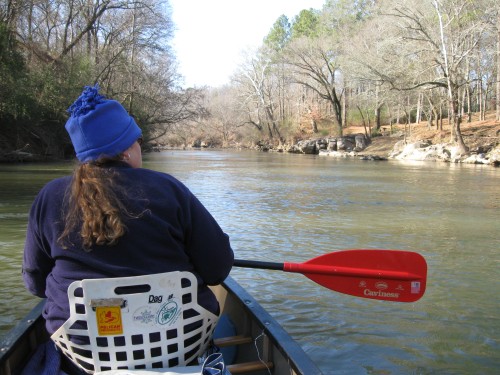On Paddle Georgia 2008 on the Flint River we learned about the Halloween Darter (and heard all those Halloween Darter jokes). We were lucky to have Mary Freeman, who discovered the Halloween Darter, along with us on Paddle Georgia to teach us all about the Flint, especially the Halloween Darter. We heard the story of how, while surveying fishes in Georgia’s Flint River, Mary and her husband Bud noticed that a certain darter fish had a striking orange color in its fins–much different than the Blackbanded darter that is prominent in the southwest Georgia River. They had come across a new species: the Halloween darter or Percina crypta.
You may be surprised to learn, though, that it wasn’t until after Paddle Georgia that the Halloween Darter “officially” became a new species.
This is what Mary had to say about completing the process to get the Halloween Darter officially declared a new species: “Hearing folks who might never have heard of a “darter” before telling Halloween darter jokes was a bit of a surprise for me, especially on that first night that I arrived at the camp at Camp Thunder. Bud and I had years ago figured out that this little darter was different than any other known to science, but frankly, finishing a species description is tedious stuff. Spending a week on the Flint with people from so many different walks of life, evincing such interest and concern about the river and what lives in it – especially those paddlers who helped pull a seine and at least acted enthused about seeing what came up in the net – really motivated me to put other projects aside and do this one thing that I could do for the Flint. That is – put an official, scientifically recognized name on one of the river’s unique critters.”
“The Halloween darter is a great example of ‘cryptic biodiversity’ — species that have gone unrecognized because they look a lot like other species that are known,” explained Mary, an ecologist with the U.S. Geological Survey and the UGA Odum School of Ecology. “Ichthyologists have documented many new fish species in the southeastern U.S., showing that despite nearly 100 years of scientific study of fishes in this region, there are still surprises.”The newly discovered Halloween darter is less than five inches long and upon analysis, was found to have a host of differences from the Blackbanded darter. The fish is common to only a few areas of the Chattahoochee and Flint River systems because it requires habitats with swift water currents over rocky areas–shoals. Findings were reported in a recent issue of prominent zoological journal Zootaxa.
According to Mary, there are far fewer shoals today because of the rise of dams on rivers and streams, as well as the removal of rock shoals to improve rivers for navigation. The discovery of the Halloween darter has definite implications for conservation strategies.
“Keeping track of the status of the Halloween darter, along with other species that require shoal habitats in the Chattahoochee and Flint Rivers, will provide information on how shoals as ecological systems are responding to changes in land use, water management and climate,” said Mary.
In addition to the Freemans, the research team included Noel Burkhead of the U.S. Geological Survey and Carrie Straight, a Ph.D. student at the UGA Odum School of Ecology.




